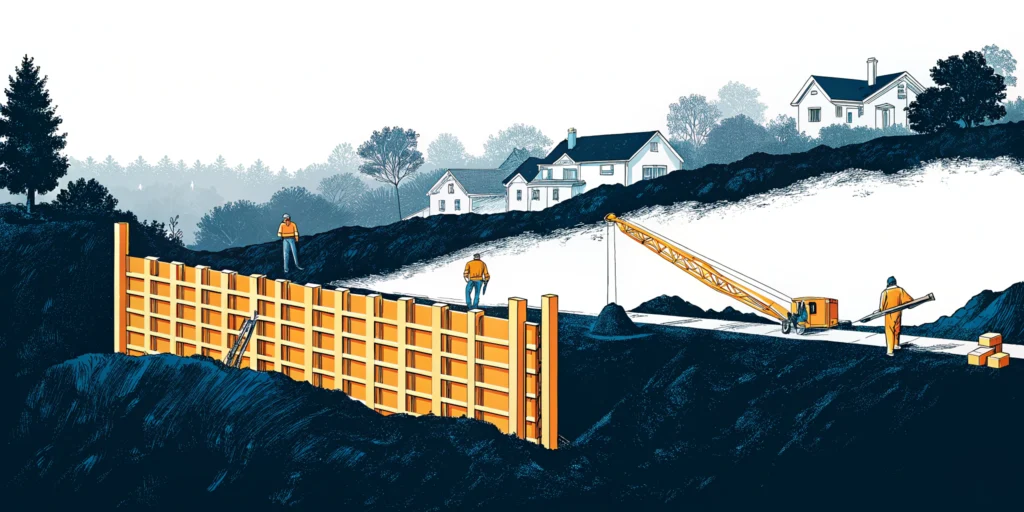When you install soldier pile and lagging panel support, you need robust excavation shoring emergency procedures from day one. Unexpected cave-ins or water seepage can put your crew at risk and delay your timeline. That’s why you need a clear plan to assess hazards and prepare response steps. It guides your team safely through any crisis.
Know shoring system basics
Soldier pile walls use steel columns driven into the ground to support vertical loads. You slide lagging panels between piles to retain soil and control movement. These components form a reliable shoring system for deep excavation. It suits tight urban sites and complex projects.
Assess emergency hazards
Identify potential risks before work begins so you handle issues swiftly. Key hazards include:
- Soil collapse from unsupported faces
- Water infiltration under hydrostatic pressure
- Toxic or flammable gas buildup
- Equipment failure or improper placement
Consider proximity to utilities, water tables, and changing weather. You can follow excavation shoring safety guidelines to ensure nothing slips through the cracks.
Prepare emergency response
A solid plan starts with thorough preparation. Take these actions:
- Conduct a detailed risk assessment with your competent person
- Schedule daily inspections of piles, panels, and shoring connections
- Deliver hands-on excavation shoring training for all crew members
- Keep rescue gear, first aid kits, and communication devices on site
We know that emergencies can be stressful. Clear procedures and regular drills help your team stay confident and ready.
Apply emergency procedures
When a crisis hits, you need fast, decisive action. Follow this step-by-step approach:
- Evacuate nonessential personnel to a safe zone
- Alert emergency services and your site supervisor immediately
- Use excavation support systems or excavation shoring equipment to stabilize the area
- Administer first aid if needed and await professional rescue teams
- Document every action with photos, times, and witness statements
Keep your team aligned with communication radios and a predefined chain of command. It prevents confusion and speeds up recovery.
Review post-incident actions
After the incident, you’ll want to restore safety and learn from the event. Your next steps should include:
- Report the incident to OSHA under the trenching and excavation standards within required timeframes
- Investigate root causes and adjust your excavation shoring regulations accordingly
- Repair or replace damaged piles, panels, and protective systems
- Update emergency procedures and retrain your crew
This cycle of action and review drives continuous improvement and solidifies compliance.
Why choose us
RuffHouse Construction LLC leads in Washington and Oregon. We specialize in complex soldier pile and lagging installations. Here’s why you can trust us:
- Fast mobilization and response keeps projects on schedule
- Certified safety programs exceed industry standards
- Comprehensive site management covers planning to post-installation review
- Proven track record on commercial and municipal projects
When you’re ready, contact us for expert support on your next deep excavation project.
FAQ
What is an excavation shoring emergency procedure?
It’s a set of steps that protect workers and equipment when a trench or shoring system fails.
How often should my team conduct emergency drills?
Hold drills at least quarterly and after any major design or site change.
Who qualifies as a competent person on site?
A competent person has the training, experience, and authority to spot hazards and take action.
What equipment is essential for trench collapse response?
You need trench boxes, shoring tools, gas detectors, first aid kits, and reliable communication devices.
How do I update my emergency plan after an incident?
Investigate the event, revise your procedures, share updates with everyone, and schedule retraining sessions.
Ready to start your own soldier pile wall project in Seattle, Tacoma, or anywhere in Puget Sound?
Learn how Ruffhouse Construction delivers safe, code-compliant soldier pile and lagging wall installations for any site.
See our Soldier Pile Installation Services for details and request a free estimate today.

